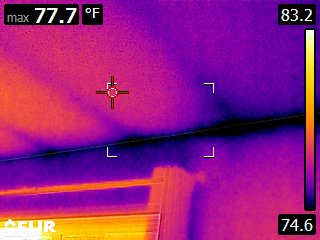
A FLIR Thermal Imaging inspection can help first time home buyers in the buying process. You may not realize technology like exists. Infrared thermal imaging cameras spot small, but key changes in temperature in different areas of a house, identifying problematic areas that the naked eye never could and some that a visual inspection could only hypothesize. A house will show up as hot, cold, or somewhere in between as we scan the house with a camera sensitive to infrared radiation.
What infrared imaging reveals during inspections
Moisture is a big issue that gets revealed during these inspections which includes hidden sources of mold, roof leaks, and posts that indicate termite nests. Electrical problems are also revealed as well as heat and energy loss, foundation cracks, structural concerns, missing insulation, ventilation glitches and rodent infestations. Let’s go through a couple of typical problems we find with the camera, which can save you a bundle of money.
Roofing leaks

Water will typically give up its heat at a slower rate than its surrounding roofing materials because of its high thermal capacity, so we can see with just one image if any areas have accumulated moisture. This is best done in the evening when the temperature outside begins to fall. The roofing materials will have released their heat showing up blue or purple on the image, while the moisturized materials will still be warm and will show up red or orange on the image. The image on the top right shows a bad leak in winter, showing up blue as the cold infiltrates the warm house.
Electrical faults
Identifying the source of electrical problems quickly and accurately will add huge value to a home, while preventing injury and property damage. The image will have yellow marks wherever there is damage to electrical systems, making it easy to spot and put on the list of repairs to be done (as you can see in the bottom right image of the light fixture).
Structural defects
When we scan walls, floors and ceilings with the camera we notice differences in temperature and conductivity which tell us about hidden missing structural components and damaged portions of these components. On top of the missing insulation (that you can see in the right most photo below), many houses will show wet basement walls which could be a potential source of mold.

The information provided by thermal imaging inspections is extremely valuable to the owner or perspective buyer of a house, but it is also worth noting that infrared home inspections also have their limits. The results must be interpreted by an expert who knows about possible sources of error in measurements such as dry areas, reflected heat, and the limit of surface readings.
When buying your dream house, make sure it doesn’t have hidden headaches with an infrared thermal image home inspection. Home sellers don’t want unexpected problems (especially the easily fixable kind) arising and scaring off a potential buyer when they get an inspection done. Even current home owners with no intentions of selling would benefit from having a thermal inspection done. Infrared technology is a good addition to a visual inspection, and doesn’t negate the need for an inspector with experience and knowledge of all systems that make up a home. As always, choose wisely!
